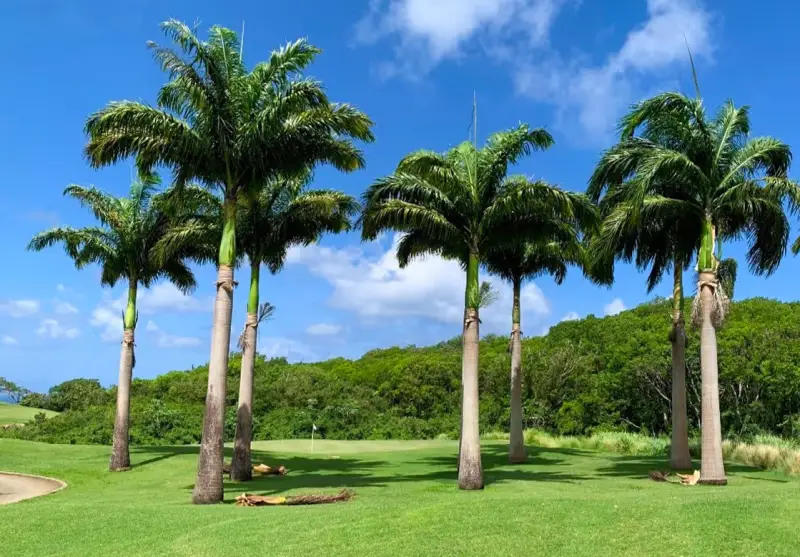The royal palm (Roystonea regia) is a breathtaking tropical tree that stands as a symbol of elegance and grandeur. With its towering height, smooth gray trunk, and gracefully arching green fronds, this palm is a favorite choice for landscaping in warm climates. Whether adorning streets, parks, or private gardens, the royal palm adds a majestic touch to any setting.
Beyond its ornamental appeal, this palm is also valued for its resilience and adaptability. However, to ensure its healthy growth and longevity, proper care and maintenance are crucial. From selecting the right planting location to providing optimal water, nutrients, and pruning, every step plays a role in cultivating a thriving royal palm.
This comprehensive guide will walk you through everything you need to know about royal palm care, helping you nurture these stunning trees to their full potential.
Understanding the Royal Palm

Royal Palm Overview
- Scientific Name: Roystonea regia
- Family: Arecaceae
- Origin: Native to Cuba, the Caribbean, and Florida
- Height: Up to 80 feet (24 meters)
- Lifespan: 100+ years
- Growth Rate: Moderate to fast-growing
- USDA Hardiness Zones: 10–11
The royal palm is a striking and iconic tree often seen lining streets, boulevards, and public parks, where it enhances the landscape with its towering presence and graceful fronds. These palms are well-adapted to tropical and subtropical climates, thriving in regions with warm temperatures and high humidity. While they can tolerate brief periods of cooler weather, they are not frost-hardy and may suffer damage if exposed to prolonged cold spells.
In their native habitat, royal palms flourish in well-drained soils, particularly in coastal areas where they can withstand occasional salt spray. Their moderate to fast growth rate allows them to develop a thick, smooth trunk topped with a crownshaft of lush, green fronds, making them a popular choice for large-scale landscaping projects. However, to maintain their health and beauty, royal palms require proper watering, fertilization, and occasional pruning.
When planted in suitable conditions within USDA Zones 10–11, these palms can grow vigorously and provide a stunning vertical element to any tropical or subtropical garden.
How to Grow Royal Palm
Growing a royal palm requires careful planning to ensure the tree thrives in its environment. From selecting the right location to proper soil preparation and planting techniques, each step plays a crucial role in the palm’s health and long-term growth.
Choosing the Right Location
Royal palms require ample space and abundant sunlight to grow efficiently. When selecting a planting site, consider the following factors:
- Full Sun Exposure: These palms thrive in full sun, requiring at least 6–8 hours of direct sunlight daily for optimal growth. Partial shade may slow growth and result in a thinner trunk.
- Spacing: Due to their large size, royal palms should be planted at least 15–20 feet apart from other trees, buildings, or power lines to allow sufficient room for their canopy and root system.
- Protection from Strong Winds: While mature royal palms are relatively wind-resistant, young palms are vulnerable to strong winds before their roots are fully established. Planting them in a somewhat sheltered location can help reduce the risk of damage.
Soil Requirements
The right soil type is essential for healthy root development and overall growth. Royal palms prefer:
- Well-Draining Soil: Sandy or loamy soil is ideal as it prevents waterlogging, which can cause root rot. If your soil is heavy clay, consider amending it with sand or organic matter to improve drainage.
- pH Range: These palms do best in slightly acidic to neutral soils, with a pH range of 6.0–7.5. Test your soil before planting and adjust with lime (to raise pH) or sulfur (to lower pH) if necessary.
- Avoid Compacted or Poorly Draining Soils: Heavy clay soils that retain excess moisture can lead to root suffocation and fungal diseases. If planting in an area with poor drainage, consider creating a raised bed or mound to improve soil conditions.
Planting Royal Palm
Proper planting ensures a strong foundation for the palm’s growth. Follow these steps for successful planting:
- Digging the Hole: Dig a hole twice as wide and as deep as the root ball. This allows the roots to spread easily and prevents transplant shock.
- Soil Preparation: Mix organic compost or well-rotted manure with the native soil to enhance nutrient content and improve drainage.
- Placing the Palm: Carefully position the palm in the hole, ensuring the base of the trunk is level with the surrounding ground. Planting too deep can lead to rot, while planting too shallow may cause instability.
- Backfilling: Fill the hole gradually with soil, gently patting it down as you go to eliminate air pockets. Avoid pressing too firmly, as compacted soil can restrict root growth.
- Watering: After planting, water the palm deeply to help settle the soil and encourage root establishment. Continue watering regularly, especially in the first few months, to support healthy growth.
Watering and Fertilization
Proper watering and fertilization are crucial for maintaining the health and vibrant appearance of royal palms. These trees require consistent moisture and essential nutrients to thrive, but overwatering or improper fertilization can lead to health issues. Understanding the right techniques ensures optimal growth and longevity.
Watering Schedule
Royal palms need a well-regulated watering routine to establish strong roots and support healthy frond development. The frequency of watering depends on the tree’s age and environmental conditions.
- Newly Planted Trees: Water three to four times a week for the first three months to help the roots establish. Ensure the soil stays evenly moist but not waterlogged. Using a slow, deep watering method allows moisture to penetrate deeply, encouraging strong root growth.
- Established Trees: Once the tree is well-rooted, reduce watering frequency to once a week, providing deep irrigation to maintain soil moisture. Royal palms prefer soil that is consistently moist but not soggy, as prolonged waterlogging can lead to root rot.
- Drought Conditions: During extended dry periods or extreme heat, increase watering frequency to prevent stress. Monitor the soil moisture level by checking the top few inches—if dry, provide deep watering. Mulching around the base of the tree can help retain soil moisture and reduce evaporation.
Best Fertilizer for Royal Palm
Royal palms require a nutrient-rich diet to maintain lush fronds and a healthy trunk. A specialized palm fertilizer ensures the tree receives the essential minerals needed for growth.
- Type of Fertilizer: Use a slow-release palm fertilizer with a balanced formula that includes nitrogen (N), phosphorus (P), potassium (K), and magnesium (Mg). These nutrients support frond development, root strength, and overall tree health. Look for a fertilizer with a ratio such as 8-2-12-4 (N-P-K-Mg) to prevent common deficiencies.
- Application Frequency: Apply fertilizer three to four times a year, typically in spring, summer, and fall. Avoid fertilizing in winter, as the tree’s growth slows down during cooler months.
- How to Apply: Spread the fertilizer evenly around the base of the tree, extending it to the edge of the canopy (drip line). Avoid direct contact with the trunk, as this can cause burns and damage to the palm. Water the area thoroughly after application to help nutrients absorb into the soil.
Pruning and Maintenance
Proper pruning and maintenance play a crucial role in keeping royal palms healthy, aesthetically pleasing, and free from potential hazards. Regular care ensures that the tree remains strong, resistant to pests and diseases, and maintains its natural beauty.
When and How to Prune
Pruning royal palms should be done carefully to avoid unnecessary stress on the tree. Unlike some other palm species, royal palms naturally shed their older fronds as they age, reducing the need for frequent pruning. However, occasional trimming helps maintain the tree’s health and appearance.
Remove dead, yellowing, or damaged fronds to promote growth and prevent potential safety hazards, such as falling fronds. Old fronds that hang down naturally can be removed, but those still green and healthy should be left intact.
Do not over-prune, as excessive removal of fronds can weaken the tree by reducing its ability to photosynthesize. Over-pruning also makes the palm more vulnerable to disease, nutrient deficiencies, and environmental stress. Always leave several healthy green fronds to sustain the tree’s growth.
Use sharp, clean pruning tools such as pruning shears or saws to make clean cuts and reduce the risk of disease transmission. Always sanitize your tools before and after pruning, especially if the tree has been affected by disease or pests.
Common Pests and Diseases
Despite their resilience, royal palms are susceptible to certain pests and diseases that can compromise their health if not managed properly. Regular inspections and early intervention are key to preventing serious damage.
Pests Affecting Royal Palm
- Palm Weevils: These destructive pests lay eggs in the trunk, and their larvae bore into the wood, causing structural damage. Severe infestations can lead to the tree’s death. Signs of infestation include oozing sap, weakened trunks, and frond discoloration.
- Spider Mites: These tiny pests feed on palm fronds, causing discoloration and weakening of the leaves. Infested fronds may appear speckled or dusty. A strong spray of water or insecticidal soap can help control their population.
- Scale Insects: These sap-sucking pests attach themselves to fronds, leading to yellowing, wilting, and stunted growth. They also excrete a sticky substance called honeydew, which attracts sooty mold. Horticultural oils or insecticidal treatments can help manage scale infestations.
Diseases to Watch Out For
- Ganoderma Butt Rot: A deadly fungal infection that causes trunk decay and weakens the structural integrity of the palm. Infected trees often develop a conk (mushroom-like growth) at the base of the trunk. Unfortunately, there is no cure, and infected palms should be removed to prevent the spread of the disease.
- Fusarium Wilt: A serious disease that causes frond wilting, browning, and eventual death. The infection spreads through contaminated pruning tools or soil. There is no known cure, so prevention through proper sanitation and tool sterilization is essential.
- Lethal Yellowing: This disease, caused by a phytoplasma, affects the vascular system of the palm, leading to premature fruit drop, frond yellowing, and tree death. It spreads through insect vectors like planthoppers. Preventative treatments with antibiotics and resistant palm varieties are the best management strategies.
Maintaining a Healthy Royal Palm
- Conduct regular inspections to spot early signs of disease or pest infestations.
- Keep the area around the palm clean and free from debris to minimize fungal infections and pest activity.
- Avoid wounding the trunk, as cuts and damage can create entry points for diseases.
- Apply preventative pest control measures if infestations are common in your area.
Propagation and Growth Tips
Royal palms can be propagated through seed germination or by transplanting young palms. While these trees grow at a moderate to fast rate, proper care and optimal growing conditions can enhance their development and ensure a healthy, thriving tree.
Propagation Methods
Seed Germination: The most common method of propagating royal palms is through seeds. However, this process requires patience, as germination can take several weeks to months depending on environmental conditions.
- Collect fresh seeds from mature royal palms, as older seeds have lower germination rates.
- Soak the seeds in warm water for 24–48 hours to soften the outer shell and speed up germination.
- Plant the seeds in a well-draining soil mix, burying them about ½ to 1 inch deep.
- Keep the soil consistently moist but not soggy. Using a greenhouse or a humidity dome can help maintain optimal moisture levels.
- Seeds typically germinate within 6–12 weeks, but some may take longer. Once seedlings develop a few leaves, they can be transplanted into larger containers or directly into the ground.
Transplanting Young Palms: For those looking for a quicker way to grow a royal palm, purchasing nursery-grown saplings is a great alternative. These young palms are already established and can be transplanted into the landscape with minimal effort.
- Choose a healthy sapling with a strong root system and green, undamaged fronds.
- Prepare a planting hole twice as wide and as deep as the root ball to allow easy root expansion.
- Water the sapling thoroughly after transplanting and follow a regular care routine to help it establish in its new location.
Growth Enhancement Tips
To encourage faster and healthier growth, follow these essential care tips:
- Provide regular watering and fertilization. Young palms need frequent watering, especially during the first few months after planting. Established trees benefit from deep watering once a week. Fertilize three to four times a year using a slow-release palm fertilizer with essential nutrients like nitrogen, phosphorus, potassium, and magnesium.
- Ensure proper drainage to avoid root rot. Royal palms prefer well-draining sandy or loamy soil. Avoid planting them in low-lying areas where water can accumulate, as standing water can lead to root rot and fungal diseases.
- Use mulch around the base to retain moisture and regulate soil temperature. A 2–3 inch layer of organic mulch helps the soil stay cool and prevents rapid evaporation, especially during hot weather. Keep mulch a few inches away from the trunk to avoid moisture buildup, which can lead to rot.
Benefits of Growing Royal Palm
Royal palms are more than just stunning additions to a landscape—they offer both aesthetic and environmental advantages. Whether planted in residential gardens, public parks, or along streets, these towering palms enhance their surroundings while contributing to ecological balance.
Ornamental and Landscaping Value
Enhances property aesthetics with a majestic appearance. The royal palm’s tall, smooth gray trunk, lush green fronds, and graceful silhouette make it one of the most visually striking palm species. It serves as an eye-catching focal point in gardens, parks, and commercial landscapes, instantly adding a touch of elegance and sophistication.
Provides shade and improves microclimate conditions. With its large, arching fronds, the royal palm creates natural shade, making outdoor spaces more comfortable, especially in tropical and subtropical regions. This shade reduces heat buildup, helping lower temperatures in nearby areas and creating a cooler microclimate. The palm’s ability to block harsh sunlight also makes it a great choice for walkways, patios, and poolside landscapes.
Environmental Benefits
Helps absorb carbon dioxide and improve air quality. Like all trees, royal palms play a crucial role in reducing carbon dioxide levels in the atmosphere, helping combat climate change. They also filter pollutants from the air, improving air quality in urban and suburban areas.
Supports biodiversity by providing habitat for birds and insects. Royal palms attract various bird species, pollinators, and beneficial insects. The flowers provide nectar for bees and butterflies, while the fruits serve as a food source for birds, contributing to local biodiversity. By planting royal palms, homeowners and landscapers can help sustain urban wildlife populations.
Additional Benefits
- Low maintenance: Once established, royal palms require minimal care, making them a hassle-free choice for landscapers and homeowners.
- Storm resilience: These palms are naturally resistant to strong winds, making them a durable option for coastal and hurricane-prone regions.
- Drought tolerance: While they require regular watering initially, mature royal palms can withstand periods of drought, making them suitable for various climates.
Conclusion
Royal palms are a stunning addition to any landscape when properly cared for. With the right planting location, watering, fertilization, and maintenance, these trees can thrive for decades, adding beauty and elegance to any environment. By following this detailed care guide, you can ensure your royal palm grows strong and healthy for years to come.






